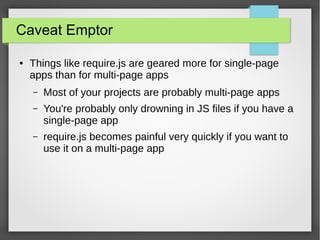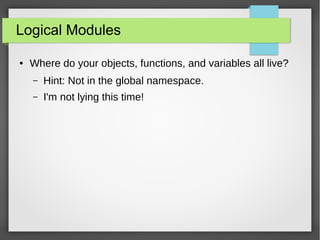Organizing JavaScript
- 1. Modules in JavaScript Or How to Break Your Code (Into Little Pieces) A Talk by Michael Cordingley
- 2. Module Types ● Modules are sometimes misunderstood – ● File Modules – Confusion in naming Each piece of code to its own file They come in different flavors – File – ● ● Logical In an ideal world, the two overlap 1:1 ● Logical Modules – Each piece of code to its own predictable code location
- 3. The Cost of Structure Three different difficulty levels – Different trade-offs of fixed versus variable costs Complexity vs. Scale Project Complexity ● Project Scale Simple Moderate Complex
- 4. File Modules ● Break your code out into separate files – ● ● Ideally, one file per idea Files should be small and logically arranged on the filesystem Don't forget about production! – Files need to be concatenated and minified as part of your build process.
- 5. File Modules – Simple ● ● If a project uses very little JavaScript, throw it it all into a single file for each page. Didn't you just say one idea per file? – ● It's more maintainable to have everything in one place, if that place isn't too cluttered. – ● I lied. We only need organization schemes when we have too much. When starting a new project, START WITH THIS ONE unless you have good reason to do otherwise!
- 6. File Modules – Moderate ● Break code out into separate files and load them each with a script tag. – ● Don't forget to bundle these into a single file that gets loaded as a giant blob for production Doesn't this get hard to keep up with all of the dependencies? – Only if you have several files – Most projects never reach that scale
- 7. Transitioning to Moderation ● ● It isn't a clean break Just start pulling your nouns out into separate files as your project acquires them – – ● These are probably reusable across pages anyway Pulling them out also encourages you to write a clean interface If you page script exceeds 200 lines, you probably have lurking nouns, or at least some code that could be DRYed out. – Please don't wait this long!
- 8. File Modules – Complex ● So you went for the moderate route and now you're drowning in files? – ● Time to level up. Pull in a formalized way to load and compile files – require.js – yepnope.js – etc.
- 9. Caveat Emptor ● Things like require.js are geared more for single-page apps than for multi-page apps – Most of your projects are probably multi-page apps – You're probably only drowning in JS files if you have a single-page app – require.js becomes painful very quickly if you want to use it on a multi-page app
- 10. Transitioning to Complexity ● ● ● Update your file module to conform to your module-loader of choice Update every usage of that module to be loaded with the module-loader Don't forget the whole concatenation/minification thing – This is where the pain ramps up – You need to define blobs ● Separate bundlings of code that load together
- 11. File Modules in the Future ● ECMAScript 6 (Harmony) will bring native modules to the language – Shim: https://github.com/ModuleLoader/es6-module-loader – Despite the shim, this is not yet ready for general consumption ● The spec isn't finished yet
- 12. Logical Modules ● Where do your objects, functions, and variables all live? – Hint: Not in the global namespace. – I'm not lying this time!
- 13. Logical Modules – Simple ● Just keep 'em in your page script – ● If you haven't broken it out into its own file anyway, it probably isn't very big or very complicated Pull it out into a logical module at the same time that you'd pull it out into a file module and for the same reasons
- 14. Logical Modules – Moderate ● OK, so it's out into its own file – Don't make it a global! – Projects get cluttered this way It needs a home that is globally-accessible ● ● ● It may be an object that you reuse across pages It may be repeated functionality – Like enhancing your site navigation
- 15. Introducing the Application Object ● Make a global – – ● But only one! For now, it's just an object literal Call it “App” or the name of your project: “FooBarFighters” – No, I'm not actually familiar with their music – Yes, the puns are always intentional, even when bad
- 16. Application Object – Continued ● Attach your modules to this object – – ● e.g. App.Navigation, App.Forms, App.InstantiableObject Submodules go as properties on their parent modules If your module needs initialization, add an “init” or “initialize” method to it. – – ● e.g. App.Navigation.initialize(); This is responsible for calling submodule intializers If you have modules that need initialization, also have an “App.initialize();” method that gets called on DOM ready
- 17. Application Object – Finish ● This application object can and should be broken out across multiple files. – The “App.initialize()” method saves you from having to worry about the order in which they load The Application object just comes first Don't forget about “this” ● ● – Useful to avoid having to bake the full module name into functions that use other functions – e.g. Inside of “App.Navigation.initialize()” “this” is “App.Navigation”
- 18. The Catch ● “This is great! Everything is cleanly separated out into its own place, but I need to load a module after the page load and then initialize it.” – ● “Oh yeah, and I don't know if it'll have loaded before the Application starts or not.” – ● OK. Um, K. “And this other piece needs to run only (before|after) the rest is all set up.” – …why are you doing this to me?
- 19. Logical Modules – Complex ● Introducing the Application object! – ● But this time, it's a real, instantiated object “var App = new Application();” – You could write the definition of “Application” yourself, but it's best not to – We'll get to that
- 20. The New Application Object ● When a new module gets loaded after the application has started, this will automatically start it. – ● Otherwise, it'll wait until the application starts It also publishes events – – ● So you can run code just before and just after the application starts It even doubles as a free event bus The modules also get events – Same deal as the Application
- 21. And where do I get this? ● What, you don't want to reinvent the wheel? – ● Fine, here it is: https://github.com/marionettejs/backbone.marionette/blob/m “But, I don't use or want Underscore, Backbone, and the whole rest of Marionette!” – Jeez, you're picky. – https://github.com/mcordingley/Appliance
- 22. The End Goal ● Reduce complexity – Whenever you introduce a new organizational tool, make sure it reduces project complexity – Use the simplest scheme you can get away with – Make things as easy as possible for anyone who has to maintain your code after you've left it behind
- 23. Thank You ● This talk can be found in article format at: – http://michaelcordingley.me/articles/when-spaghetti-overflow






















